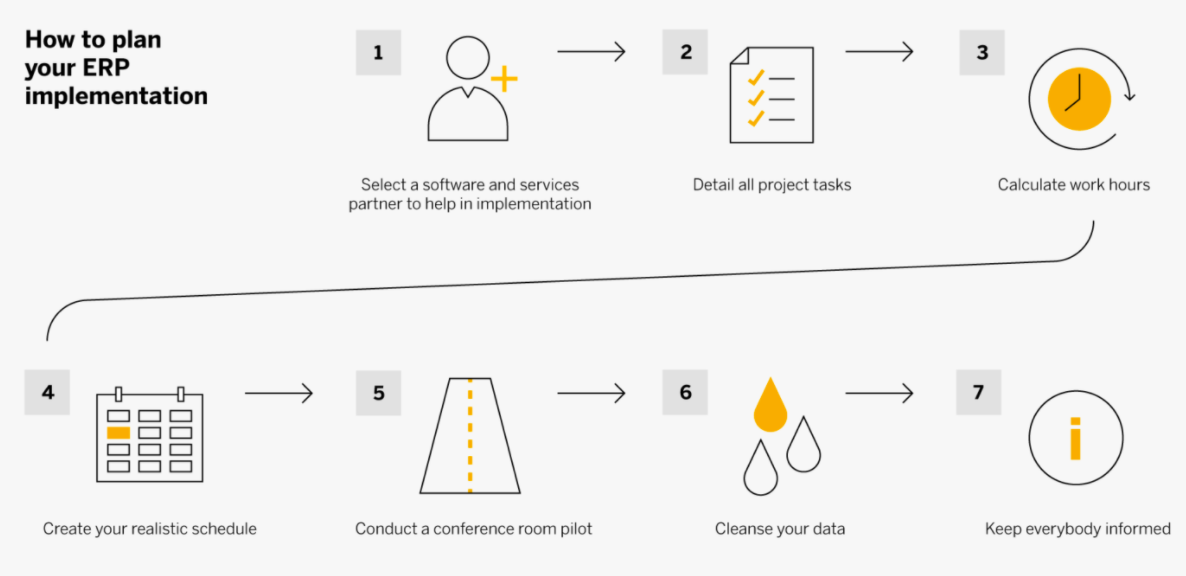Implementing an SAP ERP system takes you one step closer to organization-level digital transformation. Not only can you overcome the challenges of legacy systems, but also explore new business opportunities with modern ERP capabilities. There are many examples of businesses reaping multi-dimensional benefits out of successful SAP implementations. Case in point: National Grid, UK’s largest electricity, and gas utility company were able to step up its back-office efficiency and move to an integrated, cloud-based procurement SAP system by partnering with Wipro.
Since ERP sits at the center of the business, migrating everything from data to employees to a new system is both critical and time-consuming. A carefully planned implementation process is therefore deemed strategic for long-haul results. Regardless of business sector and size, a successful SAP ERP implementation across finance, manufacturing, HR, supply chain, services, procurement, and/or other functions is always backed by careful planning and support of the entire organization.
Steps for successful ERP implementation
A to Z of ERP implementation
There are 4 major implementation strategies for SAP ERP viz. Single-step Method, Phased Rollout, Parallel Adoption, and Hybrid Implementation. While selecting the most appropriate one depends on the state of your business and where you stand in the digital transformation journey, the overarching steps of implementation are the same for all. It is the understanding and execution of these steps that bring all the difference in the project.
If you are able to follow the steps outlined below, you can minimize the chances of budget overruns, long turnaround times, system inefficiencies, and talent gaps in the system.
1.Project preparation
The first step is preparatory. It involves everything from a conference room pilot to detailing the upcoming tasks and related work hours to cleansing data and keeping every stakeholder on board with changes.

Source: SAP Insights
2.Business blueprint/configuration
The next step is to identify in detail the necessary action items. For that, a series of workshops have to be organized with everybody involved in the project to outline the business requirements, build UX prototypes, and then foster a design-led development approach.
3.Realization/customization
Next, the organizational information is entered in SAP, the gaps and process needs are addressed, and data is prepared to be migrated to the new system. Evaluate the requirements to see if they are an ideal fit for your organization. The goal is to strive for simplicity and implementing a good simple working solution rather than an ideal solution.
4.Final preparation/data migration
The final preparation is not only system-wise but also people-wise. Everybody must be trained on the new processes with production-like data, and the complete set of processes has to be tested and validated in an SAP system.
Go-live – Comprising former system stop, final data migration, and cutover transition with the start of the new SAP system, the go-live step is very crucial as any issue could have maximum impact during this step.
5.Production support
This step marks the transformation of the project team into a dedicated problem-solving team of fewer members. To address potential gaps that were missed earlier, the managed service providers stay on their toes for assistance. For instance, global energy major BP has been leveraging the support of AWS for Information and Technology Services (IT&S) across SAP applications. Whirlpool uses IBM Cloud to manage 24/7 access to critical enterprise applications for operations efficiency and Wipro has been instrumental in end-to-end consulting, implementation, and application management of SAP SRM for National Grid.
Other critical success factors for an SAP Implementation include –
- Well defined program structure and operating model with clear accountability
- Effective template governance and demand management
- Declaration of “business process owners” to lead the transformation
- Process-oriented training to ensure a smooth transition
Pave Your Own Path
These steps can help improve decision-making and enhance productivity, efficiency, collaboration, and communication within your organization. Crafting an implementation plan that is unique to your ERP needs, business state, domain, etc helps you unlock better customer service and revenue growth opportunities.
You must consider, evaluate, and discuss all the possible options and select the best-suited implementation partner. Investing in SAP ERP is synonymous with investing in a long-term partnership with the SAP vendor. There are many vendors in the market like Wipro, AWS, Oracle, and others that offer various combinations of services. In the end, having the right experienced implementation partner will help avoid potential pitfalls. Companies like Western Digital, Skull Candy, FedEx, National Grid, and Coca-Cola have looked for security service level agreements, customization provisions, integration with in-house applications, and demonstration of a cloud platform before selecting their SAP ERP partner. You can create your own checklist of standard parameters and begin the journey towards SAP ERP for the best results!
Follow Techdee for more informative articles.





